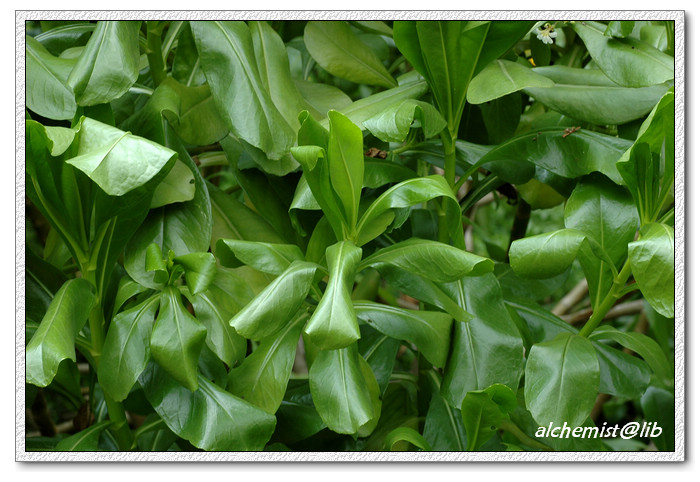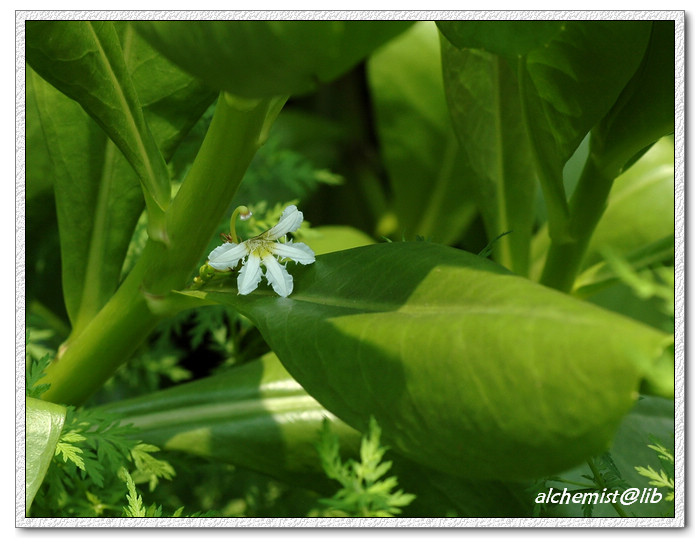草海桐 Scaevola sericea
- Scientific Name: Scaevola sericea Vahl
- Ref: Symb. Bot. 2:37. 1791
- Synonyms:
- Lobelia frutescens Mill.
- L. koenigii (Vahl) Saff.
- L. piliplena Kuntze
- L. sericea Kuntze
- L. sericea var. koenigii (M.Vahl) Kuntze
- L. velutina Kuntze
- Scaevola bela-modagani Schult.
- S. billardierei D.Dietr.
- S. chlorantha de Vriese
- S. fauriei H.Lév.
- S. frutescens (Mill.) K.Krause
- S. koenigii Vahl
- S. lambertiana de Vriese
- S. lativaga Hance
- S. leschenaultii DC.
- S. macrocalyx de Vriese
- S. piliplena Miq.
- S. plumerioides Nutt.
- S. taccada (Gaertn.) Roxb.
- S. velutina C.Presl
- English Common Name: beach cabbage, sea lettuce, beach naupaka
- Chinese Common Name: 草海桐 cǎo∙hǎitóng
- Japanese Common Name: クサトベラ [草扉/草海桐花] kusatobera
- Family: Goodeniaceae
- Genus: Scaevola
- Distribution: Open coastal sands or rocks; near sea level. Dongsha Qundao, SE Fujian, Guangdong, Guangxi, Hainan, Nansha Qundao, Taiwan, Xisha Qundao [India, Indonesia, S Japan, Malaysia, Myanmar, Papua New Guinea, Pakistan, Philippines, Sri Lanka, Thailand, Vietnam; E Africa, tropical Australia, Indian Ocean islands, Madagascar, Pacific islands].
- Photo: 06/21/2009, South China Botanical Garden, Guangdong
Shrubs or small trees, to 7 m tall, erect or diffuse. Twigs 5-10 mm in diam., sometimes rooting, hollow, usually glabrous but axils with a tuft of dense white barbate trichomes. Leaves spirally arranged, mostly aggregated at apex of branches, sessile or shortly petiolate; leaf blade spatulate to obovate, 10-22 × 4-8 cm, slightly succulent, glabrous or abaxially sparsely villous, base cuneate, apex rounded, truncate, or emarginate. Cymes axillary; bracts and bracteoles small, with a tuft of barbate trichomes in axils. Pedicel with a joint at apex. Calyx glabrous; tube obovoid; lobes linear-lanceolate, ca. 2.5 mm. Corolla white to pale yellow or purple, ca. 2 cm; tube thinly tubular, posterior side divided to base, outside glabrous, inside densely white villous; limb patent; lobes lanceolate, thickened at center, each side with a wide membranous and induplicate wing above middle, margin sparsely ciliate. Anthers connivent into a tube with basal part of indusium, becoming free after anthesis; connective longer than cells, becoming lamellar at apex. Drupe white, ovoid-globose, 7-10 mm in diam., divided longitudinally by furrows into 2 parts each 4-ribbed, 2-locular; locules each with 1 seed. Fl. and fr. Apr-Dec. 2n = 16. (Flora of China)

06/21/2009, South China Botanical Garden
